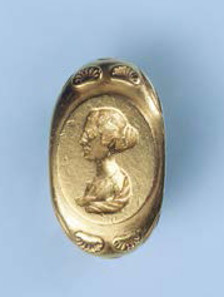August 27, 2015 – One of the world’s largest and most significant collections of rings has been bequeathed to the Swiss National Museum. The collection was established by Alice and Louis Koch. The museum is currently showing 300 selected items from the collection, illustrating the history of finger rings over a period of 4,000 years. This is a uniquely diverse collection which serves as a valuable historical reference.
The melon-style coiffure and chignon were fashionable during this period. The shell ornaments on the ring shoulders refer to the cult of Venus. Ring, around 150 AD, maker unknown, Roman Empire (Smyrna). Embossed and engraved gold. © Swiss National Museum.
The vast collection of Alice and Louis Koch, which comprises over 2,500 rings, is now on permanent loan to the Swiss National Museum. It represents the long history of finger rings, beginning in ancient Egypt, up through ancient Rome, the Middle Ages and Modernity including the 21st century. For the first time ever, an exclusive selection of items from the collection will be on exhibit at the National Museum Zurich.
A snake with open jaw entwines a naked woman, who symbolizes sexuality. The pearl represents an apple, and can thus be interpreted as a symbol of temptation. Ring, around 1900, René Lalique (1860-1945), Paris. Gold, frosted glass, pearl. © Swiss National Museum.
The exhibition features an ancient Roman gold ring depicting the portrait of the wife of Emperor Marcus Aurelius, as well as a ring made by the renowned French Art Nouveau jewellery designer René Lalique …
This piece belongs to the series ‘Water-pipe thread rings’. The section of the water pipe, which normally remains hidden, forms the decorative element. Ring, 1992, Bernhard Schobinger (born 1946), Switzerland. Iron pipe, Silver, malachite, diamonds, rubies. © Swiss National Museum.
… and modern rings created by masters such as Bernhard Schobinger of Zurich, Salome Lippuner, who was born in the canton of Valais, and the Basel designer Johanna Dahm.
History behind the Alice and Louis Koch collection
By 1912, Alice and Louis Koch had amassed the major part of their collection of nearly 2,000 historical finger rings.
The Japanese lacquer technique urushi, with its silky lustre, appears here in a new aesthetic. The coconut shell has undergone a metamorphosis. Ring, 2007, Salome Lippuner (born 1956), Switzerland. Silver, coconut shell with black lacquer, jade. © Swiss National Museum.
Louis Koch was the youngest brother of Robert Koch, court jeweller and founder of a jewellery company bearing his name in Frankfurt am Main. Louis Koch and his wife, Alice, belonged to a circle of cultivated Jewish collectors and patrons of the arts who contributed greatly to cultural life in Frankfurt up until 1933. Drawing on their family and business connections, from 1933 onwards the younger Koch generation was able to build a new home in Basel, Switzerland, as conditions in pre-World War II Germany deteriorated. As a token of the family’s gratitude, the current owner of the collection has bequeathed the collection to Switzerland, i.e. the Swiss National Museum, in the form of a permanent loan which will later convert to a gift.
Belongs to a body of work titled ‘Enhancement’. The artist jeweller learnt the lost-wax casting technique from the Ashanti in Africa and the Dokra in India. Ring, 2007, Johanna Dahm (born 1947), Switzerland. 22-carat gold, steel wire. © Swiss National Museum.
A foundation was established (the Alice and Louis Koch Foundation), and the collection was expanded by over 500 rings created by contemporary, internationally renowned jewellery designers. The collection in its entirety impressively portrays this area of jewellery-making, from its earliest beginnings right up to the present day.
To visit the website of the Swiss National Museum please click here.








